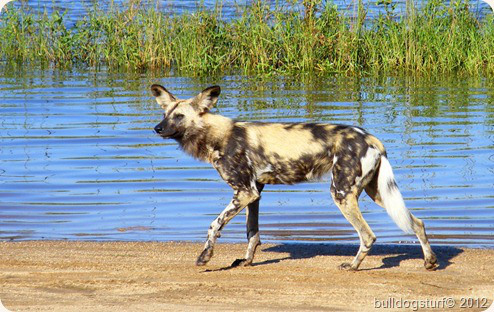African Wild Dog - Lycaon pictus
 Pack of African Wild Dogs (1)
Pack of African Wild Dogs (1)
Classification
- Kingdom - Animalia
- Phylum - Chordata
- Class - Mammalia
- Order - Carnivora
- Family - Canidae
- Genus - Lycaon
Description
African wild dogs are one of the most unique and social species of candid. African wild dogs have short wiry fur that has splotches of yellow, gray, black, and white. They have a lifespan between ten and twelve years, and usually weigh between 55 and 70 pounds, males being larger than females. African wild dogs are very unique socially - they live in packs consisting of 2 - 27 individuals, yet individuals tend to interact with others of the same sex more often than those of the opposite sex. In a pack, only the dominant male and female will breed, and one litter averages about 10 pups, larger than any other species of candid. African wild dogs breed year round, but it is much more common in March and June. All members of a pack will help take care of the pups, and the pups become fully independent after 16 to 24 months. African wild dogs are a nomadic species, and they hunt in groups so they are able to take down larger prey. The diet of African wild dogs may consist of antelopes, warthogs, wildebeest calves, rats, and birds. African Wild Dogs usually hunt during dawn and dusk to avoid predators and competition.
African wild dogs are one of the most unique and social species of candid. African wild dogs have short wiry fur that has splotches of yellow, gray, black, and white. They have a lifespan between ten and twelve years, and usually weigh between 55 and 70 pounds, males being larger than females. African wild dogs are very unique socially - they live in packs consisting of 2 - 27 individuals, yet individuals tend to interact with others of the same sex more often than those of the opposite sex. In a pack, only the dominant male and female will breed, and one litter averages about 10 pups, larger than any other species of candid. African wild dogs breed year round, but it is much more common in March and June. All members of a pack will help take care of the pups, and the pups become fully independent after 16 to 24 months. African wild dogs are a nomadic species, and they hunt in groups so they are able to take down larger prey. The diet of African wild dogs may consist of antelopes, warthogs, wildebeest calves, rats, and birds. African Wild Dogs usually hunt during dawn and dusk to avoid predators and competition.
Habitat and Range
African wild dogs can currently be found in southern and eastern Africa. African wild dogs live in a wide variety of habitats including plains, semi-deserts, bushy savannas, woodlands, and upland forests.
African wild dogs can currently be found in southern and eastern Africa. African wild dogs live in a wide variety of habitats including plains, semi-deserts, bushy savannas, woodlands, and upland forests.
Threats
- Competition and Predation - In Kruger National Park, the dogs' most abundant competition and predators are lions and hyenas.
- Habitat Fragmentation - In order to sustain a viable population, African wild dogs need large home ranges. When those ranges are broken up, population sizes decline.
- Humans - In the past, African wild dogs have been known to attack livestock, so humans tend to treat African wild dogs with hostility.
- Road Accidents
- Disease
Conservation
African wild dogs need large areas of contiguous habitat (at least ten thousand kilometers) with no human contact in order to have large sustainable populations. Additionally, there need to be public education programs to teach people not to persecute African wild dogs if they are confronted by some. Kruger National Park realizes the many threats to African wild dogs and are working to protect and conserve them. The park takes priority for its endangered species and is taking action by trying to prevent the spread of disease within the park. Thankfully, only one alien disease organism has been recorded in Kruger National Park to date.
African wild dogs need large areas of contiguous habitat (at least ten thousand kilometers) with no human contact in order to have large sustainable populations. Additionally, there need to be public education programs to teach people not to persecute African wild dogs if they are confronted by some. Kruger National Park realizes the many threats to African wild dogs and are working to protect and conserve them. The park takes priority for its endangered species and is taking action by trying to prevent the spread of disease within the park. Thankfully, only one alien disease organism has been recorded in Kruger National Park to date.
Current Status
African wild dogs are classified as endangered on the IUCN red list for endangered species and have been classified as endangered for more than 20 years. Current population estimates predict that there are approximately 6,000 African wild dogs left.
African wild dogs are classified as endangered on the IUCN red list for endangered species and have been classified as endangered for more than 20 years. Current population estimates predict that there are approximately 6,000 African wild dogs left.
For More Information on Endangered Species, Please Visit: http://www.iucnredlist.org/
Photo Sources:
(1) - http://commons.wikimedia.org/wiki/File:Wild_Dog_Kruger_National_Park_South_Africa.jpg
(2) - http://visitstothepark.wordpress.com/2012/04/09/african-wild-dog-of-the-kruger-national-park/
(1) - http://commons.wikimedia.org/wiki/File:Wild_Dog_Kruger_National_Park_South_Africa.jpg
(2) - http://visitstothepark.wordpress.com/2012/04/09/african-wild-dog-of-the-kruger-national-park/

